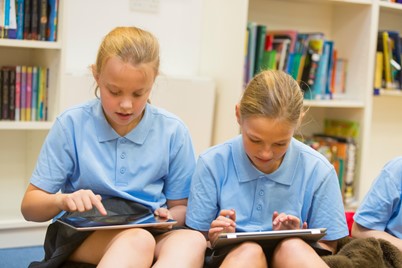ICT has much to offer literacy as it can greatly enhance the teaching and learning of it. Whilst there are many ICT tools that can be used students will only develop partial capabilities in ICT if the wrong software is chosen.
It is crucial, therefore, that when you are planning to use ICT in the literacy lesson that you decide on the role you want it to play - will it do develop student ICT capability, enhance the literacy learning or both?
Within the Australian Curriculum, the teaching of literacy and ICT capability coexists across the Learning Areas. The Literacy sub-strand in the English curriculum in particular presents many opportunities for teachers to capitalise on the use of ICT in their classrooms.
Literacy and ICT in primary school can, therefore, work synchronously in your classroom.
Australian Curriculum - Year 1 English (2018)
It is for this particular reason that I chose to develop a teacher resource for my ICT capability online course that focuses on giving teachers the knowledge and the tools they need to be effective ICT integrator at their schools. Designed to deliver practical and immediately actionable advice to teach ICT capability proficiently in literacy lessons in Primary education.
Key Themes and ICT teaching strategies
The key themes that I included in the resource are as follows:
- Australian Curriculum reference: illustrating direct link and focus on the curriculum;
- ICT capability Background context;
- Information on ICT capability and Literacy as a General Capability (straight from ACARA website);
- Practical tips when planning to teach ICT capability in literacy lessons;
- General Capability assessment - ICT capability;
- Recommended ICT tools and ICT teaching strategies including teacher ICT capability requirements;
- Expected student year level progression in ICT techniques and;
- Recommended ICT/literacy activities including information pertaining to being able to structure and stimulate learning activities and make full use of your school's resources.
This resource incorporates straight forward advice so that all you need to do is read through it and put it immediately into action. For each particular teacher resource created it will specifically be designed to meet the needs of students in different year levels starting with those in the Foundation Stage of the learning in the national curriculum.
Similar ones will also be developed for using ICT in numeracy teaching and plans have been set to include information about coding in the classroom and mobile learning methods that will further enhance a student's ICT capability.
Remember that ICT capability is more than just students learning new techniques - it is about knowing how to effectively use these techniques. As a general capability in the Australian Curriculum, it is a requirement that you are able to teach ICT capability proficiently.
Make the most of this resource and help your students to benefit greatly from proven ICT teaching strategies taken from research about the most ICT capable schools today.
Literacy with ICT in the primary classroom benefits everyone, teacher, and student, so check it out today and develop literacy and ICT in primary school today.

Embedding ICT Teaching Strategies in Literacy Lessons
When teaching literacy with ICT in the Australian Curriculum there are a number of opportunities for you as a teacher to make sound instructional decisions that would mean employing ICT teaching strategies in literacy lessons. This is because the general capability of ICT is present and encouraged to be taught alongside literacy development.
As a primary teacher, this is a great opportunity for you to develop ICT capability. The ultimate aim of ICT capability development is for you to enable students to focus on the technology as a tool to the point where it is transparent in its use whilst they are working towards another learning outcome.
Further incentive to use ICT in literacy lessons is that the best way to develop ICT capability is to provide meaningful and context-driven ICT activities – like when you are teaching literacy with ICT!
There are many good reasons why using ICT in English lessons is important and beneficial. The most prolific is the above relating to the curriculum requirements. ICT has the potential to support effective teaching and learning throughout the primary curriculum. When used, however, it is important that literacy learning remains the main objective of literacy lessons.
ICT can contribute to supporting literacy lessons by providing students with resources that allow them to focus on the specific learning objectives for literacy lessons and avoid getting bogged down on other issues. Literacy learning as you know can occur throughout the curriculum with the literacy capability skill embedded in activities. As such, teaching literacy with ICT can be enhanced using research-based ICT teaching strategies at the time of learning activities that cover literacy capability.
The ICT resources for teaching and learning literacy have specifically been developed for this purpose. When using ICT in English lessons in the primary classroom they can you with teaching strategies for literacy with ICT that focus on the development of ICT capability. Once mastered, you can employ in other learning activities throughout other key learning areas with ICT activities that also covers the literacy capability.
These literacy teaching resources will support you in your professional learning on the best teaching strategies for literacy lessons when using ICT in English lessons and ensuring that both capabilities in ICT and literacy are scaffolded throughout key learning of the Australian Curriculum.
These ICT resources for teaching and learning literacy with ICT can be purchased as a whole-school professional learning package from our online store, or you can get them for free when you join our online literacy courses for primary teachers.
I encourage you to support the teaching of literacy with ICT using our research-based ICT teaching strategies. Use ICT in literacy learning today to enhance your literacy lessons now.

ICT and Literacy Development in the Curriculum
Understanding how the use of ICT can help the Australian Curriculum literacy capability is important in harnessing the use of it for students. The development of literacy capability can not only be achieved in the English key learning area but also throughout other key learning areas.
Within the National Curriculum English learning area, you will find the development of both literacy capability and ICT capability alongside each other. This provides you the opportunity to ensure that these 21st century skills are not only promoted but also to help children understand how ICT can be used a tool to achieve goals.
So what is literacy capability? According to the Australian Curriculum General Capabilities (21st century skills) it discusses and states that:
“Literacy encompasses the knowledge and skills students need to access, understand, analyse and evaluate information, make meaning, express thoughts and emotions, present ideas and opinions, interact with others, and participate in activities at school and in their lives beyond school. Success in any learning area depends on being able to use the significant, identifiable, and distinctive literacy that is important for learning and representative of the content of that learning area.
Becoming literate is not simply about knowledge and skills. Certain behaviours and dispositions assist students to become effective learners who are confident and motivated to use their literacy skills broadly. Many of these behaviours and dispositions are also identified and supported in other general capabilities. They include students managing their own learning to be self-sufficient; working harmoniously with others; being open to ideas, opinions and texts from and about diverse cultures; returning to tasks to improve and enhance their work; and being prepared to question the meanings and assumptions in texts.”
There are several ways, therefore, for you to plan to integrate Information and Communication Technology in the classroom.
Plan to use ICT in English/literacy lessons: Research has shown that a key issue here is how to integrate ICT effectively in literacy lessons (Click the link to find the solution). How you plan will ultimately depend on the ICT resource setting at your workplace.
Literacy capability opportunities with ICT include:
- Foundation – Language strand ACELA1433 and Literacy strand ACELY1654
- Year 1 – ACELA 1450 AND ACELY 1661
- Year 2 – ACLEA 1466 and ACELY 1674
Plan to use ICT in literacy capability across the curriculum: Beyond the structure of literacy lessons in the English key learning area, children are using English/literacy in a cross-curricular way. Take for example the following:
- Publishing a Science report;
- Writing school web pages;
- Generating a historical account;
- Creating rules for the classroom.
Curriculum examples where both ICT and literacy capability can be developed:
- Science – ACSIS039
- Mathematics – ACMN076, ACMN080
- Media Arts – ACAMAM060
The issue of using ICT in literacy capability to support these wider uses of English is how to operate in the differing resource settings.
The cross-curricular opportunities for developing literacy capability teaching which uses ICT are many and varied and the limit to what is feasible will be determined by the access to the software, hardware and the Internet which the children have.
